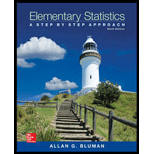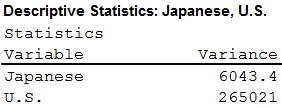
1.
To write: The null hypothesis.
1.
Answer to Problem 1AC
The null hypothesis is,
Explanation of Solution
The given data shows that the data values from the automobile magazine of 1996 June. The article compared various parameters of U.S. and Japanese-made sports cars.
The greater variability in the price of automatic transmissions for the countries is tested between the Japanese cars and the U.S. cars.
Thus, the null hypothesis can be written as,
2.
To identify: The test is used to test for any significant difference in the variances.
2.
Answer to Problem 1AC
The test is used to test for any significant difference in the variances is F-test.
Explanation of Solution
Justification:
F-test:
The F-test is used to test for the significant difference in the variances.
Here, it is observed that F-test is used to test for any significant difference in the variances.
3.
To test: Whether there is any significant difference in the variability in the prices between the Japanese cars and the U.S. cars.
3.
Answer to Problem 1AC
There is no sufficient evidence to support the claim that there is a significant difference in the variability in the prices between the German cars and the U.S. cars.
Explanation of Solution
Justification:
Step by step procedure for finding the sample variances using Minitab procedure is,
- Choose Stat > Basic Statistics > Display
Descriptive Statistics . - In Variables enter the columns Japanese and U.S. Cars.
- Choose option statistics, and select Variance.
- Click OK.
Output using Minitab procedure is,

Here, the sample variances of
Where,
Here, the variability in the price of automatic transmissions for the countries is tested. Hence, the claim is that,
Test statistic:
The formula to find the F-statistic is,
Substitute
Thus, the F-statistic value is 0.0228.
Degrees of freedom:
The degrees of freedom are
That is,
Critical value:
The level of significance is
Divide the level of significance by 2.
That is,
The critical F-value for a two-tailed test is obtained using the Table H: The F-Distribution with the level of significance 0.025.
Procedure:
- Locate 5 in the degrees of freedom, denominator row of the Table H.
- Obtain the value in the corresponding degrees of freedom, numerator column below 5.
That is,
Rejection region:
The null hypothesis would be rejected if
Conclusion:
Here, the F-value is lesser than the critical value.
That is,
Thus, it can be concluding that the null hypothesis is not rejected.
Hence, there is no sufficient evidence to support the claim that there is a significant difference in the variability in the prices between the Japanese cars and the U.S. cars.
4.
The effect of the small
4.
Answer to Problem 1AC
The effect of the small sample sizes have on the standard deviations is the small sample sizes are impacted by outliers.
Explanation of Solution
Justification:
Here, it is observed that taking the small sample sizes gives the do not give appropriate results because the small sample sizes are impacted by outliers. Thus, it can be conclude that effect of the small sample sizes have on the standard deviations is the small sample sizes are impacted by outliers.
5.
To find: The degrees of freedom are used for the statistical test.
5.
Answer to Problem 1AC
The degrees of freedom are used for the numerator and denominator is 5.
Explanation of Solution
Justification:
Form the part (3), it can be observed that the degrees of freedom are used for the numerator and denominator is 5.
6.
To check: Whether the two sets of data have significantly different variances without having significantly different means.
6.
Answer to Problem 1AC
Yes, the two sets of data have significantly different variances without having significantly different means.
Explanation of Solution
From the given information, it can be observed that the mean of the two sets of data is same in the center but the standard deviations of the two sets are different.
Thus, it can be conclude that the two sets of data have significantly different variances without having significantly different means.
Want to see more full solutions like this?
Chapter 9 Solutions
Elementary Statistics: A Step By Step Approach
- An electronics company manufactures batches of n circuit boards. Before a batch is approved for shipment, m boards are randomly selected from the batch and tested. The batch is rejected if more than d boards in the sample are found to be faulty. a) A batch actually contains six faulty circuit boards. Find the probability that the batch is rejected when n = 20, m = 5, and d = 1. b) A batch actually contains nine faulty circuit boards. Find the probability that the batch is rejected when n = 30, m = 10, and d = 1.arrow_forwardTwenty-eight applicants interested in working for the Food Stamp program took an examination designed to measure their aptitude for social work. A stem-and-leaf plot of the 28 scores appears below, where the first column is the count per branch, the second column is the stem value, and the remaining digits are the leaves. a) List all the values. Count 1 Stems Leaves 4 6 1 4 6 567 9 3688 026799 9 8 145667788 7 9 1234788 b) Calculate the first quartile (Q1) and the third Quartile (Q3). c) Calculate the interquartile range. d) Construct a boxplot for this data.arrow_forwardPam, Rob and Sam get a cake that is one-third chocolate, one-third vanilla, and one-third strawberry as shown below. They wish to fairly divide the cake using the lone chooser method. Pam likes strawberry twice as much as chocolate or vanilla. Rob only likes chocolate. Sam, the chooser, likes vanilla and strawberry twice as much as chocolate. In the first division, Pam cuts the strawberry piece off and lets Rob choose his favorite piece. Based on that, Rob chooses the chocolate and vanilla parts. Note: All cuts made to the cake shown below are vertical.Which is a second division that Rob would make of his share of the cake?arrow_forward
- Three players (one divider and two choosers) are going to divide a cake fairly using the lone divider method. The divider cuts the cake into three slices (s1, s2, and s3). If the choosers' declarations are Chooser 1: {s1 , s2} and Chooser 2: {s2 , s3}. Using the lone-divider method, how many different fair divisions of this cake are possible?arrow_forwardTheorem 2.6 (The Minkowski inequality) Let p≥1. Suppose that X and Y are random variables, such that E|X|P <∞ and E|Y P <00. Then X+YpX+Yparrow_forwardTheorem 1.2 (1) Suppose that P(|X|≤b) = 1 for some b > 0, that EX = 0, and set Var X = 0². Then, for 0 0, P(X > x) ≤e-x+1²² P(|X|>x) ≤2e-1x+1²² (ii) Let X1, X2...., Xn be independent random variables with mean 0, suppose that P(X ≤b) = 1 for all k, and set oσ = Var X. Then, for x > 0. and 0x) ≤2 exp Σ k=1 (iii) If, in addition, X1, X2, X, are identically distributed, then P(S|x) ≤2 expl-tx+nt²o).arrow_forward
- Theorem 5.1 (Jensen's inequality) state without proof the Jensen's Ineg. Let X be a random variable, g a convex function, and suppose that X and g(X) are integrable. Then g(EX) < Eg(X).arrow_forwardCan social media mistakes hurt your chances of finding a job? According to a survey of 1,000 hiring managers across many different industries, 76% claim that they use social media sites to research prospective candidates for any job. Calculate the probabilities of the following events. (Round your answers to three decimal places.) answer parts a-c. a) Out of 30 job listings, at least 19 will conduct social media screening. b) Out of 30 job listings, fewer than 17 will conduct social media screening. c) Out of 30 job listings, exactly between 19 and 22 (including 19 and 22) will conduct social media screening. show all steps for probabilities please. answer parts a-c.arrow_forwardQuestion: we know that for rt. (x+ys s ا. 13. rs. and my so using this, show that it vye and EIXI, EIYO This : E (IX + Y) ≤2" (EIX (" + Ely!")arrow_forward
- Theorem 2.4 (The Hölder inequality) Let p+q=1. If E|X|P < ∞ and E|Y| < ∞, then . |EXY ≤ E|XY|||X|| ||||qarrow_forwardTheorem 7.6 (Etemadi's inequality) Let X1, X2, X, be independent random variables. Then, for all x > 0, P(max |S|>3x) ≤3 max P(S| > x). Isk≤narrow_forwardTheorem 7.2 Suppose that E X = 0 for all k, that Var X = 0} x) ≤ 2P(S>x 1≤k≤n S√2), -S√2). P(max Sk>x) ≤ 2P(|S|>x- 1arrow_forwardarrow_back_iosSEE MORE QUESTIONSarrow_forward_ios
 MATLAB: An Introduction with ApplicationsStatisticsISBN:9781119256830Author:Amos GilatPublisher:John Wiley & Sons Inc
MATLAB: An Introduction with ApplicationsStatisticsISBN:9781119256830Author:Amos GilatPublisher:John Wiley & Sons Inc Probability and Statistics for Engineering and th...StatisticsISBN:9781305251809Author:Jay L. DevorePublisher:Cengage Learning
Probability and Statistics for Engineering and th...StatisticsISBN:9781305251809Author:Jay L. DevorePublisher:Cengage Learning Statistics for The Behavioral Sciences (MindTap C...StatisticsISBN:9781305504912Author:Frederick J Gravetter, Larry B. WallnauPublisher:Cengage Learning
Statistics for The Behavioral Sciences (MindTap C...StatisticsISBN:9781305504912Author:Frederick J Gravetter, Larry B. WallnauPublisher:Cengage Learning Elementary Statistics: Picturing the World (7th E...StatisticsISBN:9780134683416Author:Ron Larson, Betsy FarberPublisher:PEARSON
Elementary Statistics: Picturing the World (7th E...StatisticsISBN:9780134683416Author:Ron Larson, Betsy FarberPublisher:PEARSON The Basic Practice of StatisticsStatisticsISBN:9781319042578Author:David S. Moore, William I. Notz, Michael A. FlignerPublisher:W. H. Freeman
The Basic Practice of StatisticsStatisticsISBN:9781319042578Author:David S. Moore, William I. Notz, Michael A. FlignerPublisher:W. H. Freeman Introduction to the Practice of StatisticsStatisticsISBN:9781319013387Author:David S. Moore, George P. McCabe, Bruce A. CraigPublisher:W. H. Freeman
Introduction to the Practice of StatisticsStatisticsISBN:9781319013387Author:David S. Moore, George P. McCabe, Bruce A. CraigPublisher:W. H. Freeman





